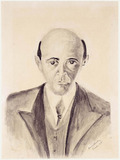Felix Nussbaum: Self-portrait with Tea Towel, painting (1935)
Felix Nussbaum: Self-portrait with Tea Towel, painting (1935)
The effect of exile on one’s own facial features was the subject of a series of self-portraits by painter Felix Nussbaum which were created in front of a mirror beginning in 1936. Under the deformation of his face and the external reality laid over his face like a grimace, Nussbaum sought an inner, undisguised self. Through the series of paintings Nussbaum wanted to assert himself against the political conditions of his identity. The painting Self-portrait with Tea Towel is the last in this series of self-portraits.
The painting shows Nussbaum against a silhouette of roofs in the Belgian city of Ostende. He has tied a tea towel around his naked upper body. Nussbaum had fled to Ostende in 1935. His cousin reported that many emigrants took such kitchen towels, which were seen as typically German, with them into exile. Few were able to take much luggage with them. In exile, therefore, even a kitchen towel could provide a small hint of familiarity. Laid over a trunk it even appeared cosy, according to the same cousin’s description. Nussbaum, too, missed the sense of domestic security in exile. The tea towel, which barely disguises the nakedness of his upper body, could be an expression of this longing. Like the tea towel, too, his curious head covering could also point to an identity conflict which a persecuted Jew such as Nussbaum experienced. The blue and white dish towel evokes a prayer shawl. The head covering also resembles a cross between an artist’s beret, the upturned cone of a dunce’s cap and the hat of a medieval Jew.



